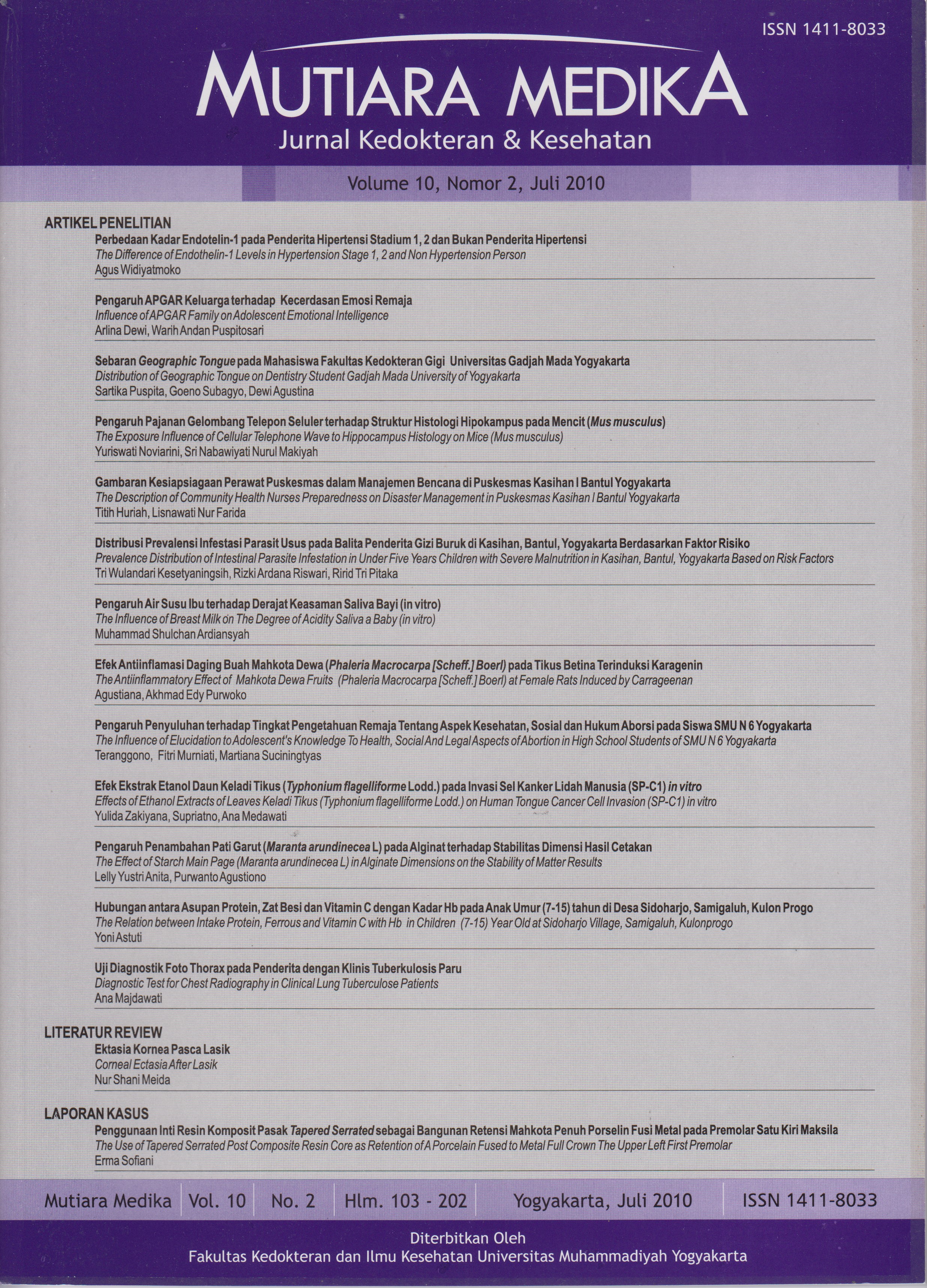Distribusi Prevalensi Infestasi Parasit Usus pada Balita Penderita Gizi Buruk di Kasihan, Bantul, Yogyakarta Berdasarkan Faktor Risiko
DOI:
https://doi.org/10.18196/mmjkk.v10i2.1575Keywords:
parasit usus, balita, gizi buruk, faktor risiko, intestinal parasite, under five year old, malnutrition, risk factorsAbstract
Malnutrition is still a public health problem in Indonesia. Severe malnutrition increasing susceptibility to the infection, and the infection is the direct factor influencing nutrition status. Intestinal parasite infestation make worse the sufferer and inhibit the elimination programme. The research purpose is to know the prevalence of intestinal parasite infestation in under five year children with severe malnutrition, and express to its risk factor of intestinal parasite infestation. The subject is all of under five children with severe malnutrition recorded in Primary Health Care in Kasihan, Bantul, Yogyakarta. Questionnaire and medical record data used to find the risk factors: acces to primary health care, parent ’s formal education, history of chronic infection and social-economic status. Direct and indirect method of faeces examination were carried out by two persons to find cysts or nematode’s eggs. The prevalence of intestinal protozoa infestation are Entamoeba histolytica (56,2%), Entamoeba coli (43,48%), Giardia lamblia (21,74%) and Balantidium coli (4,35%). Infestation of intestinal nematodes are Ascaris lumbricoides (52,17%), hook worm (13,04%) and Enterobius vermicularis (8,96%). The protrude condition of subject family are 84% low social-economic status; 96% low and medium category of parent’s formal education degree; 40% have no sanitation facilities and 64% subject with chronic disease.
Gizi buruk merupakan masalah kesehatan masyarakat yang penting di Indonesia. Gizi buruk menyebabkan penderita rentan terhadap infeksi. Infeksi merupakan faktor langsung yang mempengaruhi gizi buruk. Infestasi parasit usus mengakibatkan penderita gizi buruk menjadi lebih buruk lagi, sehingga menghambat usaha pemberantasan gizi buruk di masyarakat. Penelitian ini bertujuan untuk mengetahui prevalensi infestasi parasit usus pada balita penderita gizi buruk dan distribusi prevalensinya berdasarkan faktor risiko. Subyek penelitian adalah semua balita gizi buruk di Puskesmas Kasihan I dan II, Bantul, Yogyakarta. Kuesioner dan catatan medik untuk mendapatkan data faktor risiko yaitu akses dengan pelayanan kesehatan, tingkat pendidikan orang tua, riwayat infeksi kronis dan tingkat sosial ekonomi. Pemeriksaan feses dengan metode langsung dan tidak langsung untuk menemukan sista atau telur cacing, dilakukan sebanyak dua kali dengan pemeriksa berbeda. Prevalensi infestasi protozoa usus pada balita penderita gizi buruk adalah Entamoeba histolytica (56,52%), Entamoeba coli (43,48%), Giardia lamblia (21,74%), dan 4,35% Balantidium coli. Infestasi cacing usus: Ascaris lumbricoides (52,17%), cacing tambang (13,04%) dan Enterobius vermicularis (8,69%). Kondisi yang menonjol pada keluarga balita gizi buruk adalah 84% berstatus sosial ekonomi rendah, 96% orang tua berpendidikan rendah dan sedang serta 40% mempunyai sarana sanitasi memadai; 64% terinfeksi penyakit kronis.
References
Nency, Y., dan M.T. Arifin. 2005. Perkembangan dan Penanggulangan Gizi Buruk di Indonesia. Semarang.
Garrow, J.R. 2000. Malnutrition. Child Welfare League of America. Diakses 21 Maret 2007. http://www.cwla.org/ programs/health/healthtipsmalnutrition. htm
Nemer, L., Gelband H. and Jha, P 2001. The Evidence Base for Intervensions to Recude malnutrition in Chidren Under five and School-age Children in Low and Middle-Income Countries. CMH Working paper Series, Paper No.WG5:11. Diakses 18 Mei 2006. http://www.who. int./en/
Depkes. 2005. Perkembangan Penanggulangan Gizi Buruk di Indonesia Tahun 2005. Diakses 9 Maret 2006. http://www.depkes.co.id
Garcia, L.S., and Bruckner, D.A. 1996. Diagnostik Parasitologi Kedokteran. EGC. Jakarta. Hal. 5-51.
Markell, E.K., Voge, M., and John, D.T. 2006. Medical Parsitology 9th. Ed. Philadelphia, London, Toronto, Mexicocity, Riodejaneiro, Sydney, Tokyo, Hongkong. Pp. 20-78.
Gillespie, S.H. and Hawkey, P.M. 1995. Medical Parasitology. A practical Approach. Oxford University Press. Oxford. New York. Tokyo. pp 84.
Sastroamidjojo, S. 1980. Hubungan keadaan gizi dengan infeksi parasit. Cermin Dunia Kedokteran. Nomor Khusus. Diakses tanggal 20 Oktober 2010 dari http://www.kalbe.co.id/files/ cdk/files/25HubunganGiziParasit020. pdf/25HubunganGiziParasit020.html
Jamil, M.D. dan Francisca, E. 2009. Hubungan antara infestasi cacing usus, status haemoglobin dengan prestasi belajar anak SD Inpres Sereh Sentani, Jayapura. Diakses tgl 20 Oktober 2010 dari http://dawamjamil.blogspot.com/
Mutalazimah. 2005. Hubungan Lingkar Lengan Atas (Lila) Dan Kadar Hemoglobin (Hb) Ibu Hamil dengan Berat Bayi Lahir di RSUD Dr. Moewardi Surakarta. Jurnal Penelitian Sains & Teknologi, Vol. 114 Ol. 6, No. 2, 2005: 114 - 126.
Downloads
Published
Issue
Section
License
Copyright
Authors retain copyright and grant Mutiara Medika: Jurnal Kedokteran dan Kesehatan (MMJKK) the right of first publication with the work simultaneously licensed under an Attribution 4.0 International (CC BY 4.0) that allows others to remix, adapt and build upon the work with an acknowledgment of the work's authorship and of the initial publication in Mutiara Medika: Jurnal Kedokteran dan Kesehatan (MMJKK).
Authors are permitted to copy and redistribute the journal's published version of the work (e.g., post it to an institutional repository or publish it in a book), with an acknowledgment of its initial publication in Mutiara Medika: Jurnal Kedokteran dan Kesehatan (MMJKK).
License
Articles published in the Mutiara Medika: Jurnal Kedokteran dan Kesehatan (MMJKK) are licensed under an Attribution 4.0 International (CC BY 4.0) license. You are free to:
- Share — copy and redistribute the material in any medium or format.
- Adapt — remix, transform, and build upon the material for any purpose, even commercially.
This license is acceptable for Free Cultural Works. The licensor cannot revoke these freedoms as long as you follow the license terms. Under the following terms:
Attribution — You must give appropriate credit, provide a link to the license, and indicate if changes were made. You may do so in any reasonable manner, but not in any way that suggests the licensor endorses you or your use.
- No additional restrictions — You may not apply legal terms or technological measures that legally restrict others from doing anything the license permits.



